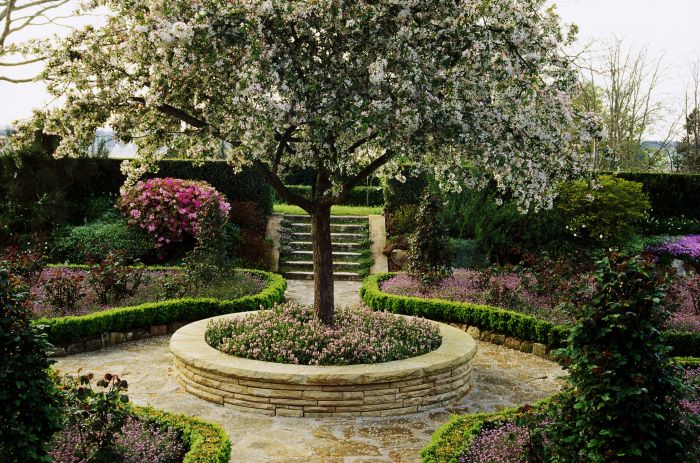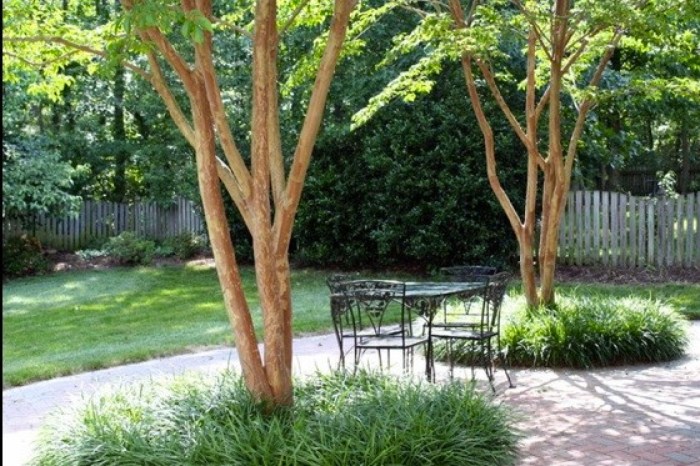Best Small Trees to Plant Near a House
Planting and Care

Best small trees to plant near house – Planting a small tree near your house can significantly enhance its curb appeal and provide shade or privacy. However, successful tree growth requires careful planning and consistent care. This section details the essential steps for planting and maintaining your new tree, ensuring its long-term health and beauty.
Planting a Small Tree
Proper planting is crucial for a young tree’s establishment. Digging a hole that’s appropriately sized and placing the tree at the correct depth are key factors influencing its survival and growth. Insufficient space can restrict root development, while planting too deeply can suffocate the roots.
- Dig the Hole: Dig a hole twice as wide as the root ball but only as deep as the root ball itself. This allows for proper root expansion.
- Prepare the Soil: Loosen the soil at the bottom of the hole to encourage root penetration. If your soil is heavy clay, amending it with compost will improve drainage and aeration.
- Position the Tree: Carefully place the tree in the hole, ensuring the top of the root ball is level with the surrounding ground. Avoid planting it too deep.
- Backfill the Hole: Gently backfill the hole with the amended soil, avoiding compacting it. Loose soil allows for better root growth.
- Water Thoroughly: Water deeply and slowly after planting to settle the soil and help the roots establish contact with the surrounding earth. A slow, deep watering is far more effective than several shallow waterings.
- Mulch the Base: Apply a 2-3 inch layer of mulch around the base of the tree, keeping it a few inches away from the trunk to prevent rot. This helps retain moisture and suppress weeds.
Regular Tree Care
Ongoing care is essential for a healthy, thriving tree. This includes fertilization, pruning, and pest and disease management. Neglecting these aspects can lead to stunted growth, disease, or even death.
Fertilization
Young trees benefit from regular fertilization to support their growth. Use a slow-release fertilizer formulated for trees, following the package directions carefully. Over-fertilizing can be harmful, so it’s crucial to follow the recommended application rates. A soil test can help determine if your soil is deficient in any specific nutrients.
Pruning, Best small trees to plant near house
Pruning helps maintain the tree’s shape, removes dead or diseased branches, and promotes strong growth. It’s best to prune during the dormant season (late winter or early spring).
- Identify Dead or Damaged Branches: Begin by removing any dead, diseased, or damaged branches. These can harbor pests and diseases.
- Shape the Tree: Carefully remove any crossing or rubbing branches to prevent damage and maintain the tree’s desired shape. Make clean cuts just outside the branch collar.
- Remove Water Sprouts and Suckers: Water sprouts and suckers are vigorous shoots that grow from the trunk or branches. Removing them helps maintain the tree’s form and directs energy to the main branches.
- Use Proper Pruning Tools: Always use sharp, clean pruning tools to prevent damage to the tree and the spread of disease.
Pest and Disease Control
Regularly inspect your tree for signs of pests or diseases. Early detection and treatment are crucial for preventing serious problems. Contact a certified arborist if you suspect a significant infestation or disease. Using appropriate organic methods, such as insecticidal soap or neem oil, can often effectively control many common pests.
Yo, thinking about sprucing up your yard with some rad small trees? Things like crape myrtles or Japanese maples are pretty chill. But if you’re more into the pixelated life, check out how to plant trees in Terraria – terraria how to plant trees – it’s surprisingly similar to the real deal, just way less dirt under your fingernails! Back to real life though, remember to consider sunlight and space when picking your perfect mini-trees.
Protecting Young Trees from Harsh Weather
Young trees are particularly vulnerable to damage from strong winds, heavy snow, or ice. Protecting them during harsh weather is crucial for their survival. Techniques include staking the tree to provide support against wind damage and wrapping the trunk with burlap to protect it from sunscald and frost cracking. In areas with heavy snow, you might need to gently brush snow off the branches to prevent breakage.
Maintenance Schedule for a Newly Planted Small Tree
| Month | Task |
|---|---|
| 1-3 | Water deeply and regularly, especially during dry periods. Monitor for pests and diseases. |
| 4-6 | Apply a slow-release fertilizer. Mulch as needed. |
| 7-9 | Water as needed, paying close attention during hot, dry spells. Check for pests and diseases. |
| 10-12 | Prepare the tree for winter. If necessary, protect it from harsh weather conditions. |
Potential Problems and Solutions: Best Small Trees To Plant Near House

Planting trees near your house offers many benefits, but it’s crucial to be aware of potential issues to ensure a harmonious coexistence. Ignoring these potential problems can lead to costly repairs and even compromise the structural integrity of your home. This section will Artikel common problems, their causes, and effective solutions.
Root Damage to Foundations and Plumbing
Tree roots, especially those of larger trees, can cause significant damage to foundations and underground plumbing. Aggressive root systems seeking water and nutrients can penetrate cracks in foundations, causing structural instability over time. Similarly, roots can infiltrate pipes, leading to blockages and leaks. Preventing this requires careful tree selection and strategic planting. Choose trees with less aggressive root systems, such as those with fibrous roots instead of deep taproots.
Planting at a sufficient distance from the house is paramount; a general guideline suggests planting small trees at least 10-15 feet away from the foundation, depending on the mature size of the tree. Regular inspection of your foundation and plumbing for any signs of root intrusion is also recommended. If root damage is detected, professional intervention may be necessary.
Consider installing root barriers during planting to help contain root growth. These barriers are typically made of plastic or metal and are installed around the root ball before planting.
Pests and Diseases Affecting Small Trees
Small trees, like any living organism, are susceptible to various pests and diseases. Common pests include aphids, spider mites, and borers. Aphids suck sap from leaves, causing stunted growth and leaf curling. Spider mites create webs and feed on leaves, resulting in stippling and discoloration. Borers tunnel into the trunk and branches, weakening the tree’s structure.
Diseases like fungal leaf spots and root rot can also significantly impact tree health. Effective control measures involve regular monitoring for signs of infestation or disease. Early detection is key. Treatment options include insecticidal soaps for aphids and spider mites, pruning infected branches, and applying appropriate fungicides for fungal diseases. In severe cases, professional arborist intervention may be necessary.
Maintaining tree health through proper watering, fertilization, and sanitation practices helps prevent pest and disease problems.
Leaf Drop, Poor Flowering, and Stunted Growth
Leaf drop, poor flowering, and stunted growth are common indicators of underlying problems. Excessive leaf drop can be due to stress from drought, nutrient deficiencies, or pest infestations. Poor flowering may be caused by inadequate sunlight, incorrect pruning, or improper fertilization. Stunted growth can result from insufficient water, nutrient deficiencies, root damage, or disease. Addressing these issues requires diagnosing the root cause.
Proper watering, balanced fertilization, and appropriate pruning techniques are crucial. Ensuring adequate sunlight and improving soil drainage can also significantly improve tree health. If the problem persists despite these measures, consulting a professional arborist for diagnosis and treatment is advisable.
Common Tree Problems, Causes, and Solutions
| Problem | Cause | Solution | Additional Notes |
|---|---|---|---|
| Root Damage to Foundation | Aggressive root growth, insufficient planting distance | Plant trees further from the house, install root barriers | Regular inspection of foundation for cracks |
| Aphid Infestation | Aphids feeding on sap | Insecticidal soap application, strong water spray | Monitor regularly for re-infestation |
| Leaf Spot Disease | Fungal infection | Remove infected leaves, apply fungicide | Ensure good air circulation around the tree |
| Stunted Growth | Nutrient deficiency, root damage, insufficient water | Soil testing, balanced fertilization, proper watering | Address any underlying issues like root damage |
Commonly Asked Questions
What are the best small trees for windy areas?
Trees with strong, flexible branches and deep root systems, such as Eastern Redbud or Serviceberry, generally fare better in windy conditions.
How often should I water a newly planted small tree?
Water deeply and regularly, especially during the first year, aiming for consistent soil moisture but avoiding waterlogging. Frequency depends on rainfall and soil type.
Can I plant a small tree too close to a power line?
No. Always check with your local utility company before planting near power lines to avoid potential hazards.
What should I do if my small tree isn’t growing well?
Consider factors like soil quality, sunlight, watering, and potential pests or diseases. Soil testing and consulting a local arborist can help diagnose the problem.
